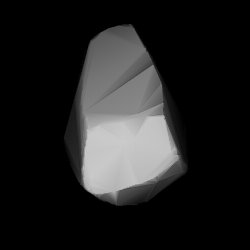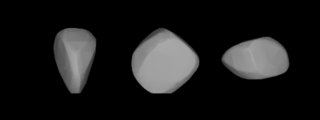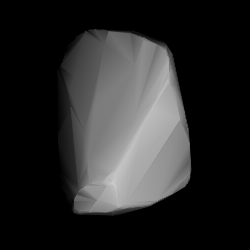997 Priska, provisional designation 1923 NR, is a carbonaceous Adeonian asteroid from the central regions of the asteroid belt, approximately 19 kilometers in diameter. It was discovered on 12 July 1923, by astronomer Karl Reinmuth at the Heidelberg-Königstuhl State Observatory in southwest Germany. The asteroid's name is a common German female name, unrelated to the discoverer's contemporaries.
La Paz, provisional designation 1923 PD, is a carbonaceous asteroid from the outer region of the asteroid belt, approximately 40 kilometers in diameter. It was discovered on 31 October 1923, by German astronomer Max Wolf at the Heidelberg-Königstuhl State Observatory and named after the city La Paz in Bolivia.
1015 Christa, provisional designation 1924 QF, is a dark background asteroid from the outermost regions of the asteroid belt, approximately 96 kilometers in diameter. It was discovered on 31 January 1924, by German astronomer Karl Reinmuth at the Heidelberg-Königstuhl State Observatory in southwest Germany. The meaning of this asteroids's name is unknown.
1057 Wanda, provisional designation 1925 QB, is a carbonaceous background asteroid from the outer region of the asteroid belt, approximately 43 kilometers in diameter. It was discovered by Grigory Shajn at the Simeiz Observatory in 1925, and later named after Polish–Soviet writer Wanda Wasilewska. The asteroid has a rotation period of 28.8 hours.
1092 Lilium, provisional designation 1924 PN, is a dark, carbonaceous background asteroid from the outer regions of the asteroid belt, approximately 44 kilometers in diameter. It was discovered on 12 January 1924, by German astronomer Karl Reinmuth at the Heidelberg Observatory in southwest Germany. The asteroid was named after the flower Lilium.
1123 Shapleya, provisional designation 1928 ST, is a stony Florian asteroid from the inner regions of the asteroid belt, approximately 11 kilometers in diameter. It was discovered on 21 September 1928, by Russian astronomer Grigory Neujmin at Simeiz Observatory on the Crimean peninsula. It was named after American astronomer Harlow Shapley.
1215 Boyer, provisional designation 1932 BA, is a stony Eunomian asteroid from the central region of the asteroid belt, approximately 20 kilometers in diameter. It was discovered by astronomer Alfred Schmitt in 1932, who named it after French astronomer and college Louis Boyer.

1335 Demoulina, provisional designation 1934 RE, is a stony Florian asteroid from the inner regions of the asteroid belt, approximately 7 kilometers in diameter. Discovered by Karl Reinmuth at Heidelberg Observatory in 1934, the asteroid was named after Prof. Demoulin, a Belgian astronomer at Ghent University. It has a slower-than average spin rate of nearly 75 hours.
1541 Estonia, provisional designation 1939 CK, is an asteroid from the central regions of the asteroid belt, approximately 21 kilometers in diameter. It was discovered on 12 February 1939, by astronomer Yrjö Väisälä at the Iso-Heikkilä Observatory near Turku, Finland. The asteroid was named after the Baltic country of Estonia.
1267 Geertruida, provisional designation 1930 HD, is a carbonaceous background asteroid from the inner regions of the asteroid belt, approximately 20 kilometers in diameter. Discovered by astronomer Hendrik van Gent at Johannesburg Observatory in 1930, the asteroid was later named after Geertruid Pels, sister of Dutch astronomer Gerrit Pels.

1337 Gerarda, provisional designation 1934 RA1, is a dark background asteroid from the outer regions of the asteroid belt, approximately 40 kilometers in diameter. It was discovered on 9 September 1934, by Dutch astronomer Hendrik van Gent at the Union Observatory in Johannesburg, South Africa. The asteroid was named after Gerarda Prins, the wife of an orbit computer at Leiden Observatory.
2016 Heinemann, provisional designation 1938 SE, is a carbonaceous Themistian asteroid from the outer regions of the asteroid belt, approximately 22 kilometers in diameter. It was discovered on 18 September 1938, by German astronomer Alfred Bohrmann at Heidelberg Observatory in southwest Germany, and later named after ARI-astronomer Karl Heinemann (1898–1970).
1524 Joensuu, provisional designation 1939 SB, is a carbonaceous asteroid from the outer region of the asteroid belt, approximately 42 kilometers in diameter. It was discovered on 18 September 1939, by Finnish astronomer Yrjö Väisälä at Turku Observatory in Southwest Finland, and named for the town of Joensuu.

1607 Mavis, provisional designation 1950 RA, is a stony asteroid from the central region of the asteroid belt, approximately 12 kilometers in diameter. It was discovered on 3 September 1950, by South African astronomer Ernest Johnson at Johannesburg Observatory in South Africa. It was later named after the wife of astronomer Jacobus Bruwer.
2043 Ortutay, provisional designation 1936 TH, is a dark asteroid from the outer regions of the asteroid belt, approximately 45 kilometers in diameter. The asteroid was discovered by Hungarian astronomer György Kulin at the Konkoly Observatory, Budapest, on 12 November 1936. It was named after Hungarian ethnographer Gyula Ortutay.
1297 Quadea, provisional designation 1934 AD, is an Eoan asteroid from the outer regions of the asteroid belt, approximately 23 kilometers in diameter. It was discovered on 7 January 1934, by astronomer Karl Reinmuth at the Heidelberg-Königstuhl State Observatory in Germany. The asteroid was named for the parents-in-law of the discoverer's brother.
1760 Sandra, provisional designation 1950 GB, is a carbonaceous asteroid from the outer regions of the asteroid belt, approximately 35 kilometers in diameter. It was discovered on 10 April 1950, by South African astronomer Ernest Johnson at Union Observatory in Johannesburg, and named after his granddaughter Sandra.
1330 Spiridonia, provisional designation 1925 DB, is a dark background asteroid of primitive composition, located in the outer regions of the asteroid belt, approximately 65 kilometers in diameter. It was discovered on 17 February 1925, by Soviet astronomer Vladimir Albitsky at the Simeiz Observatory on the Crimean peninsula. The asteroid was named after the discoverer's brother-in-law, Spiridon Zaslavskij.
1323 Tugela, provisional designation 1934 LD, is a dark background asteroid from the outer regions of the asteroid belt, approximately 60 kilometers in diameter. It was discovered on 19 May 1934, by South African astronomer Cyril Jackson at the Union Observatory in Johannesburg. The asteroid was named for the Tugela River in western South Africa.
1466 Mündleria, provisional designation 1938 KA, is a carbonaceous asteroid from the inner regions of the asteroid belt, approximately 22 kilometers in diameter.



